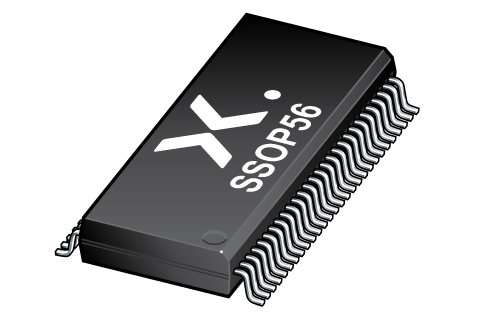
Register once, drag and drop ECAD models into your CAD tool and speed up your design.
Click here for more information74ALVCH16501DL
18-bit universal bus transceiver; 3-state
The 74ALVCH16501 is an 18-bit universal transceiver with bus hold inputs and 3-state outputs. Data flow in each direction is controlled by output enable (OEAB and OEBA), latch enable (LEAB and LEBA), and clock (CPAB and CPBA) inputs. For A-to-B data flow, the device operates in the transparent mode when LEAB is HIGH. When LEAB is LOW, the A data is latched if CPAB is held at a HIGH or LOW logic level. If LEAB is LOW, the A-bus data is stored in the latch/flip-flop on the LOW-to-HIGH transition of CPAB. When OEAB is HIGH, the outputs are active. When OEAB is LOW, the outputs are in the high-impedance state. Data flow for B-to-A is similar to that of A-to-B but uses OEBA, LEBA and CPBA. The output enables are complimentary (OEAB is active HIGH and OEBA is active LOW). This device is fully specified for partial power down applications using IOFF. The IOFF circuitry disables the output, preventing the potentially damaging backflow current through the device when it is powered down.
Features and benefits
Wide supply voltage range from 1.2 V to 3.6 V
CMOS low power dissipation
Direct interface with TTL levels
Current drive ±24 mA at VCC = 3.0 V
Universal bus transceiver with D-type latches and D-type flip-flops capable of operating in transparent, latched or clocked mode
Bus hold on all data inputs
Output drive capability 50 Ω transmission lines at 85 °C
3-state non-inverting outputs for bus-oriented applications
Latch-up performance exceeds 100 mA per JESD78 Class II.A
-
Complies with JEDEC standards:
JESD8-7 (1.65 V to 1.95 V)
JESD8-5 (2.3 V to 2.7 V)
JESD8C/JESD36 (2.7 V to 3.6 V)
-
ESD protection:
- HBM: ANSI/ESDA/JEDEC JS-001 class 2 exceeds 2000 V
- CDM: ANSI/ESDA/JEDEC JS-002 class C3 exceeds 1000 V
Specified from -40 °C to +85 °C
Parametrics
| Type number | Package name |
|---|---|
| 74ALVCH16501DL | SSOP56 |
Package
All type numbers in the table below are discontinued.
| Type number | Orderable part number, (Ordering code (12NC)) | Status | Marking | Package | Package information | Reflow-/Wave soldering | Packing |
|---|---|---|---|---|---|---|---|
| 74ALVCH16501DL | 74ALVCH16501DL,112 (935263882112) |
Obsolete | ALVCH16501 Standard Procedure Standard Procedure |

SSOP56 (SOT371-1) |
SOT371-1 |
SSOP-TSSOP-VSO-REFLOW
SSOP-TSSOP-VSO-WAVE |
Not available |
| 74ALVCH16501DL,118 (935263882118) |
Obsolete | ALVCH16501 Standard Procedure Standard Procedure | Not available |
Environmental information
All type numbers in the table below are discontinued.
| Type number | Orderable part number | Chemical content | RoHS | RHF-indicator |
|---|---|---|---|---|
| 74ALVCH16501DL | 74ALVCH16501DL,112 | 74ALVCH16501DL |
|
|
| 74ALVCH16501DL | 74ALVCH16501DL,118 | 74ALVCH16501DL |
|
|
Series
Documentation (7)
| File name | Title | Type | Date |
|---|---|---|---|
| 74ALVCH16501 | 18-bit universal bus transceiver; 3-state | Data sheet | 2024-07-01 |
| AN90063 | Questions about package outline drawings | Application note | 2025-03-12 |
| alvch16501 | alvch16501 IBIS model | IBIS model | 2013-04-08 |
| Nexperia_package_poster | Nexperia package poster | Leaflet | 2020-05-15 |
| SOT371-1 | plastic, shrink small outline package; 56 leads; 0.635 mm pitch; 18.45 mm x 7.5 mm x 2.8 mm body | Package information | 2020-04-21 |
| SSOP-TSSOP-VSO-REFLOW | Footprint for reflow soldering | Reflow soldering | 2009-10-08 |
| SSOP-TSSOP-VSO-WAVE | Footprint for wave soldering | Wave soldering | 2009-10-08 |
Support
If you are in need of design/technical support, let us know and fill in the answer form we'll get back to you shortly.
Longevity
The Nexperia Longevity Program is aimed to provide our customers information from time to time about the expected time that our products can be ordered. The NLP is reviewed and updated regularly by our Executive Management Team. View our longevity program here.
Models
| File name | Title | Type | Date |
|---|---|---|---|
| alvch16501 | alvch16501 IBIS model | IBIS model | 2013-04-08 |
How does it work?
The interactive datasheets are based on the Nexperia MOSFET precision electrothermal models. With our interactive datasheets you can simply specify your own conditions interactively. Start by changing the values of the conditions. You can do this by using the sliders in the condition fields. By dragging the sliders you will see how the MOSFET will perform at the new conditions set.